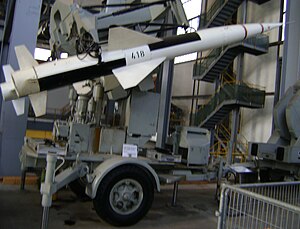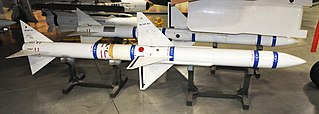
The AIM-7 Sparrow is an American medium-range semi-active radar homing air-to-air missile operated by the United States Air Force, United States Navy, United States Marine Corps, and various other air forces and navies. Sparrow and its derivatives were the West's principal beyond visual range (BVR) air-to-air missile from the late 1950s until the 1990s. It remains in service, although it is being phased out in aviation applications in favor of the more advanced AIM-120 AMRAAM.

A surface-to-air missile (SAM), also known as a ground-to-air missile (GTAM) or surface-to-air guided weapon (SAGW), is a missile designed to be launched from the ground to destroy aircraft or other missiles. It is one type of anti-aircraft system; in modern armed forces, missiles have replaced most other forms of dedicated anti-aircraft weapons, with anti-aircraft guns pushed into specialized roles.
Semi-automatic command to line of sight (SACLOS) is a method of missile command guidance. In SACLOS, the operator must continually point a sighting device at the target while the missile is in flight. Electronics in the sighting device and/or the missile then guide it to the target.
Semi-active radar homing (SARH) is a common type of missile guidance system, perhaps the most common type for longer-range air-to-air and surface-to-air missile systems. The name refers to the fact that the missile itself is only a passive detector of a radar signal—provided by an external ("offboard") source—as it reflects off the target. Semi-active missile systems use bistatic continuous-wave radar.
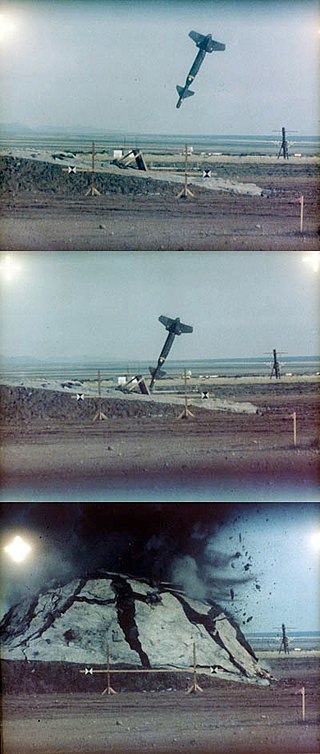
Missile guidance refers to a variety of methods of guiding a missile or a guided bomb to its intended target. The missile's target accuracy is a critical factor for its effectiveness. Guidance systems improve missile accuracy by improving its Probability of Guidance (Pg).
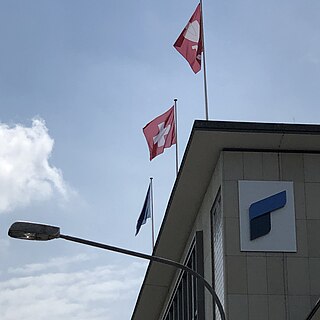
Rheinmetall Air Defence AG is a division of German armament manufacturer Rheinmetall, created when the company's Oerlikon Contraves unit was renamed on 1 January 2009 and integrated with Rheinmetall's other air-defence products. Oerlikon Contraves was a Swiss anti-aircraft artillery manufacturer famous for its adaptation of the 1916 20 mm Becker as the Oerlikon 20 mm autocannon design, which was used in the Second World War and still in use today. Copies and derivatives of these designs were made by German, French, British and Japanese weapon manufacturers. Oerlikon Contraves was purchased by Rheinmetall in 1999.

RIM-7 Sea Sparrow is a U.S. ship-borne short-range anti-aircraft and anti-missile weapon system, primarily intended for defense against anti-ship missiles. The system was developed in the early 1960s from the AIM-7 Sparrow air-to-air missile as a lightweight "point-defense" weapon that could be retrofitted to existing ships as quickly as possible, often in place of existing gun-based anti-aircraft weapons. In this incarnation, it was a very simple system guided by a manually aimed radar illuminator.
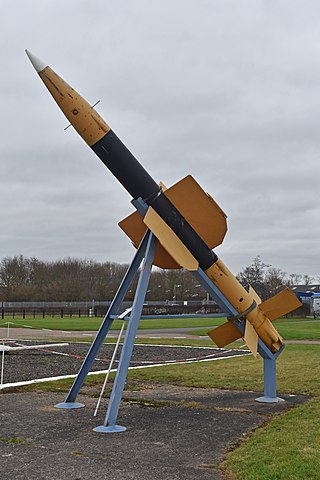
Seaslug was a first-generation surface-to-air missile designed by Armstrong Whitworth for use by the Royal Navy. Tracing its history as far back as 1943's LOPGAP design, it came into operational service in 1961 and was still in use at the time of the Falklands War in 1982.

Fireflash was the United Kingdom's first air-to-air guided missile to see service with the Royal Air Force. Constructed by Fairey Aviation, the missile utilised radar beam riding guidance. Fireflash had relatively limited performance and required the launching aircraft to approach the target from a limited angle astern.
Beam-riding, also known as Line-Of-Sight Beam Riding (LOSBR), beam guidance or radar beam riding is a technique of directing a missile to its target by means of radar or a laser beam. The name refers to the way the missile flies down the guidance beam, which is aimed at the target. It is one of the simplest guidance systems and was widely used on early missile systems, however it had a number of disadvantages and is now found typically only in short-range roles.

The Oerlikon/Martin Marietta Air Defense Anti Tank System is a dual-purpose short range surface-to-air and anti-tank missile system based on the M113A2 vehicle. The ADATS missile is a laser-guided supersonic missile with a range of 10 kilometers, with an electro-optical sensor with TV and Forward Looking Infrared (FLIR). The carrying vehicle also has a search radar with an effective range of over 25 kilometers.

The Oerlikon GDF or Oerlikon 35 mm twin cannon is a towed anti-aircraft gun made by Oerlikon Contraves. The system was originally designated 2 ZLA/353 ML but this was later changed to GDF-001. It was developed in the late 1950s and is used by around 30 countries.

The English Electric Thunderbird was a British surface-to-air missile produced for the British Army. Thunderbird was primarily intended to attack higher altitude targets at ranges up to approximately 30 miles (48 km), providing wide-area air defence for the Army in the field. anti-aircraft guns were still used for lower altitude threats. Thunderbird entered service in 1959 and underwent a major mid-life upgrade to Thunderbird 2 in 1966, before being slowly phased out by 1977. Ex-Army Thunderbirds were also operated by the Royal Saudi Air Force after 1967.

The Martin Mace was a ground-launched cruise missile developed from the earlier Martin TM-61 Matador. It used a new self-contained navigation system that eliminated the need to get updates from ground-based radio stations, and thereby allowed it to fly further beyond the front lines. To take advantage of this longer practical range, Mace was larger than Matador and could travel a longer total distance.
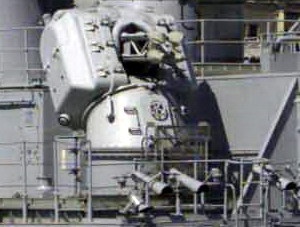
Sea Zenith is a four-barrelled 25 mm CIWS used by the Turkish Navy on their MEKO 200 frigates, like the Barbaros and Yavuz classes. It was developed in the 1980s by Oerlikon Contraves around their Oerlikon KBB gun and manufactured in Switzerland. This automatic gun uses a 25x184mm cartridge at a rate of 800 rounds a minute. Using four independent guns instead of one multi-barrelled rotary cannon improves reliability. The system is mounted in an enclosed automatic turret and directed by the Seaguard radar developed by Contraves. The turret is tilted back to allow a higher elevation to intercept diving missiles. The system's primary purpose is defence against anti-ship missiles, and other precision guided weapons. However it can also be employed against fixed/rotary wing aircraft, ships and other small craft, coastal targets, and floating mines.

The General Dynamics Mauler was a self-propelled anti-aircraft missile system designed to a late 1950s US Army requirement for a system to combat low-flying high-performance tactical fighters and short-range ballistic missiles.

Sea Killer is an Italian anti-ship missile family. The latest development of the system is known as Marte. Marte is a sea skimming, subsonic, anti-ship missile, it carries a 70 kilograms (150 lb) semi-armour piercing warhead. It has been built in several versions, with differing guidance systems, and is suitable for launching from ships or aircraft.

RSE Kriens was a Swiss-developed surface-to-air missile. It never entered service. It was named Kriens after Kriens, a village located in the canton of Lucerne.

The RSA is one of the earliest surface-to-air missiles systems, developed by the Swiss companies Oerlikon-Bührle and Contraves starting in 1947. The missile went through a rapid development process with several upgraded versions, and was the first anti-aircraft missile offered for commercial sale when it was placed on the market in the RSC-50 form. The US tested 25 of the slightly different RSC-51 model under the name MX-1868. No further sales were forthcoming. Several improved versions followed, including the RSC-54, RSC-56, RSC-57 and RSC/RSD-58. These saw small numbers of sales, mostly as training rounds.
Oerlikon-Bührle was a Swiss armaments company based in Oerlikon (Zürich) from 1906 to 1999.
